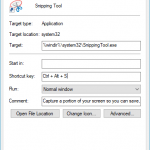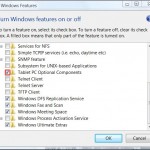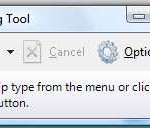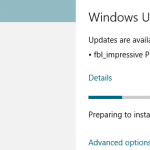Snipping Tool is a useful screen capturing comes included in Windows operating system Windows XP Tablet edition and has been regular feature in Windows Vista, Window 7, Windows 8 and Windows 10. Snipping Tool is available for free, and can be a total replacement and free alternative for the popular SnagIt screen capture software. However, when using Snipping Tool there is obvious shortcoming, that is unable to capture ‘temporary’ or ‘non-permanent’ or ‘disappear-on-lost-focus’ objects on the desktop.
To start capturing using Snipping Tool, usually users have to run Snipping Tool (which will automatically open in snipping mode) or click on “New” button in the Snipping Tool window. Whichever way, the focus on the objects or windows to capture will definitely be lost. If you’re trying to take snapshot of normal opened window or a portion of the desktop screen estate or whole screen, there won’t be any problem to snip and capture them into image. However, when come to ‘focus-sensitive’ object component on Windows desktop, there will be a hard time to capture the image of them.
One typical example is Start Menu, which only show up when user clicks on Start button, and auto hide or disappear when user clicks on other place. The same goes to contextual menu that appears when user right clicks on a file, folder, icon, shortcut, link, window, Taskbar, toolbar, desktop or any other objects in Windows. The right click context menu will auto close when user click on something else, such as to start new snip (capture). Other possible failure include unable to capture mouseover effects when mouse is placed on top of them such as highlighted words, JavaScript buttons or tooltip. When mouse is moved, the effect will subside.
Luckily Snipping Tool has a built-in undocumented hotkey or shortcut to trigger snipping process instead of having to press “New” button every time. The keyboard shortcut to start snipping is Ctrl+Print Screen. So in order to capture a snip of menu, right click contextual menu, tooltip, mouse over effects and many other on-focus changes, use the following steps:
- Run Snipping Tool by searching or clicking the Start button, then go to All Programs, clicking Accessories, and then clicking Snipping Tool. If you cannot find Snipping Tool, here’s how to install Snipping Tool.
- Snipping Tool should automatically enter snipping mode to allow you to capture screenshot. Press ESC button or click on Cancel button on Snipping Tool window to cancel snipping.
- Open the menu or place your mouse over object to trigger the effects, highlights or tooltips or whatever things that you want to capture.
- Press CTRL + PRINT SCREEN keys simultaneously. The hotkey will only work with Snipping Tool opens.
- System should freeze everything on screen intact and allows user to capture everything that are previously unable to capture. Click the arrow next to the New button, select a snip type from the menu, and then use your mouse or tablet pen to capture the screen area that you want to put into image.
With this trick, the Snipping Tool is almost as good as payable SnagIt, and can works on complete replacement alternative for all other screen capture software.







